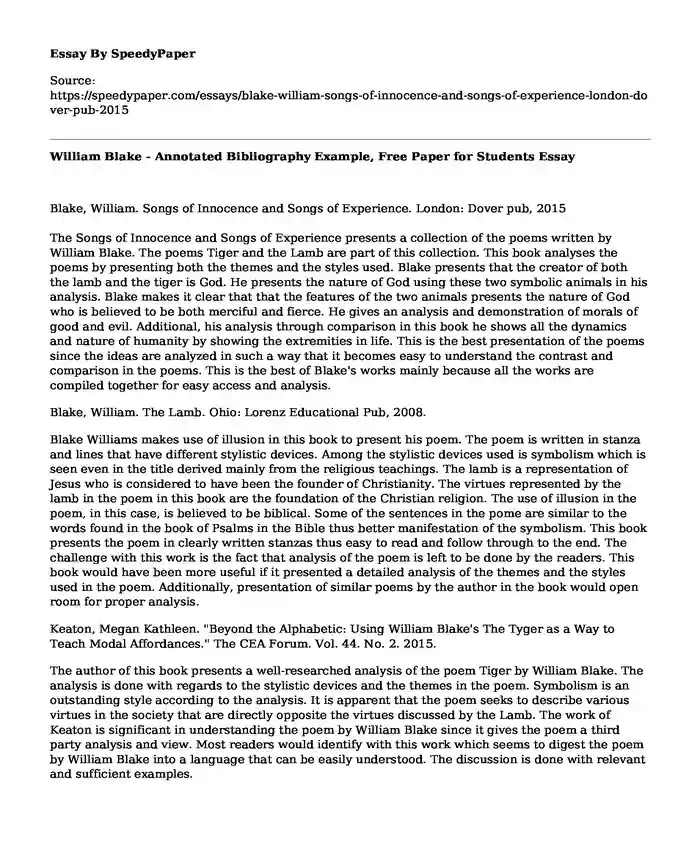
| Type of paper: | Essay |
| Categories: | William Blake |
| Pages: | 3 |
| Wordcount: | 551 words |
Blake, William. Songs of Innocence and Songs of Experience. London: Dover pub, 2015
The Songs of Innocence and Songs of Experience presents a collection of the poems written by William Blake. The poems Tiger and the Lamb are part of this collection. This book analyses the poems by presenting both the themes and the styles used. Blake presents that the creator of both the lamb and the tiger is God. He presents the nature of God using these two symbolic animals in his analysis. Blake makes it clear that that the features of the two animals presents the nature of God who is believed to be both merciful and fierce. He gives an analysis and demonstration of morals of good and evil. Additional, his analysis through comparison in this book he shows all the dynamics and nature of humanity by showing the extremities in life. This is the best presentation of the poems since the ideas are analyzed in such a way that it becomes easy to understand the contrast and comparison in the poems. This is the best of Blake's works mainly because all the works are compiled together for easy access and analysis.
Blake, William. The Lamb. Ohio: Lorenz Educational Pub, 2008.
Blake Williams makes use of illusion in this book to present his poem. The poem is written in stanza and lines that have different stylistic devices. Among the stylistic devices used is symbolism which is seen even in the title derived mainly from the religious teachings. The lamb is a representation of Jesus who is considered to have been the founder of Christianity. The virtues represented by the lamb in the poem in this book are the foundation of the Christian religion. The use of illusion in the poem, in this case, is believed to be biblical. Some of the sentences in the pome are similar to the words found in the book of Psalms in the Bible thus better manifestation of the symbolism. This book presents the poem in clearly written stanzas thus easy to read and follow through to the end. The challenge with this work is the fact that analysis of the poem is left to be done by the readers. This book would have been more useful if it presented a detailed analysis of the themes and the styles used in the poem. Additionally, presentation of similar poems by the author in the book would open room for proper analysis.
Keaton, Megan Kathleen. "Beyond the Alphabetic: Using William Blake's The Tyger as a Way to Teach Modal Affordances." The CEA Forum. Vol. 44. No. 2. 2015.
The author of this book presents a well-researched analysis of the poem Tiger by William Blake. The analysis is done with regards to the stylistic devices and the themes in the poem. Symbolism is an outstanding style according to the analysis. It is apparent that the poem seeks to describe various virtues in the society that are directly opposite the virtues discussed by the Lamb. The work of Keaton is significant in understanding the poem by William Blake since it gives the poem a third party analysis and view. Most readers would identify with this work which seems to digest the poem by William Blake into a language that can be easily understood. The discussion is done with relevant and sufficient examples.
Cite this page
William Blake - Annotated Bibliography Example, Free Paper for Students. (2022, Feb 22). Retrieved from https://speedypaper.net/essays/blake-william-songs-of-innocence-and-songs-of-experience-london-dover-pub-2015
Request Removal
If you are the original author of this essay and no longer wish to have it published on the SpeedyPaper website, please click below to request its removal:
- Free Essay Example on Human Interleukin Genes
- Essay Example in Writing: Final Exam Questions
- Teen Pregnancy
- Essay Sample on Public Relation in the Contemporary Society
- Building a Stable Democracy in Iraq, Free Essay
- Response Essay on the Presentation Why Diversity Is Upside Down
- "The Road" by Cormac McCarthy, Bird Box" book by Josh Malerman, and "The Passage" by Justin Cronin
Popular categories




